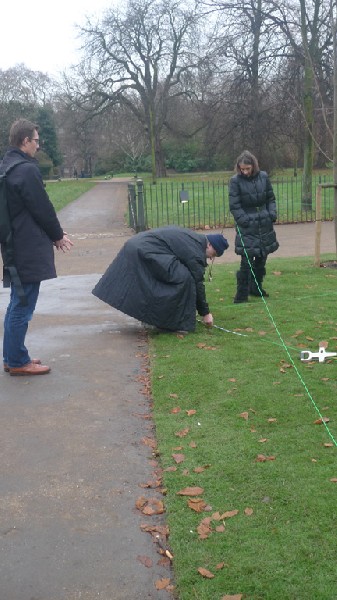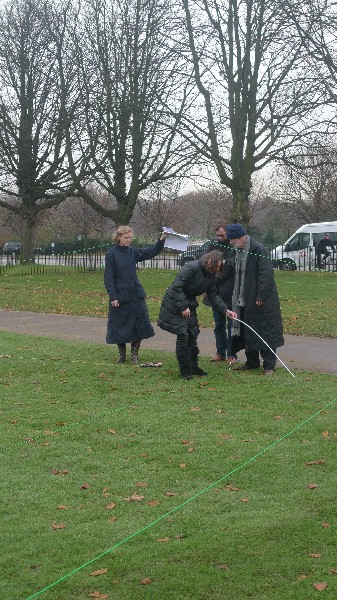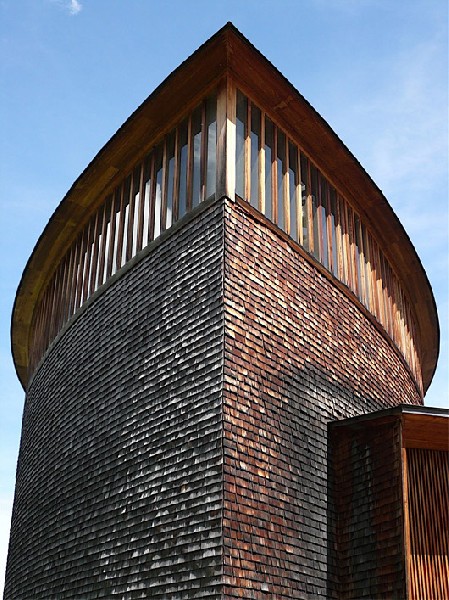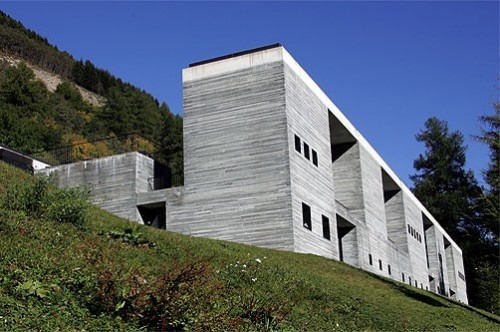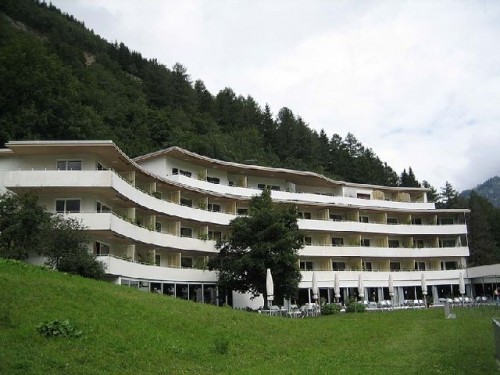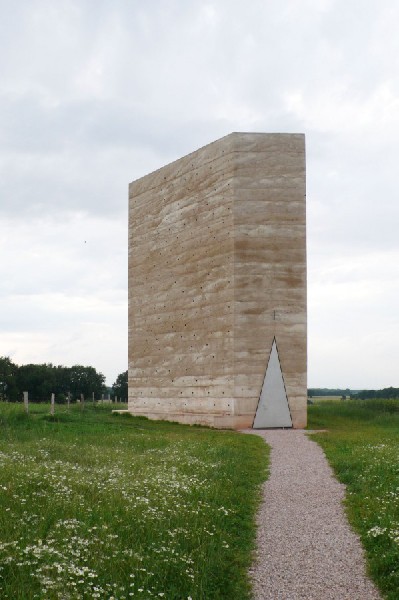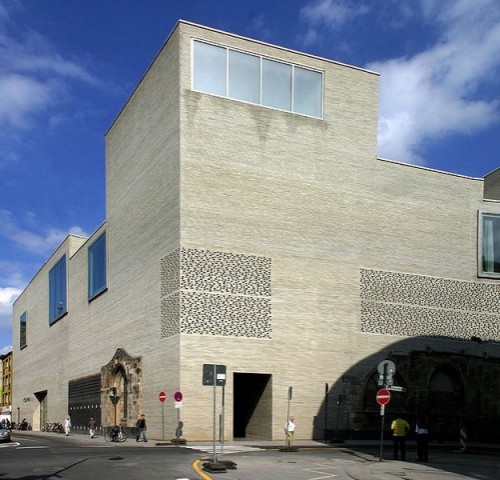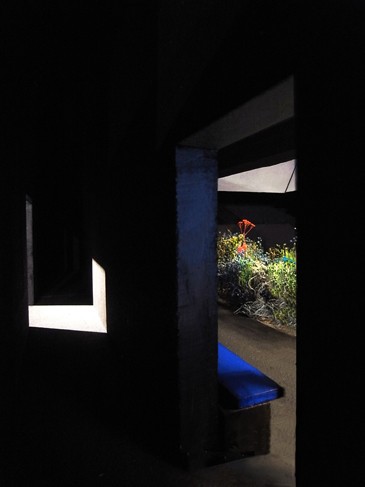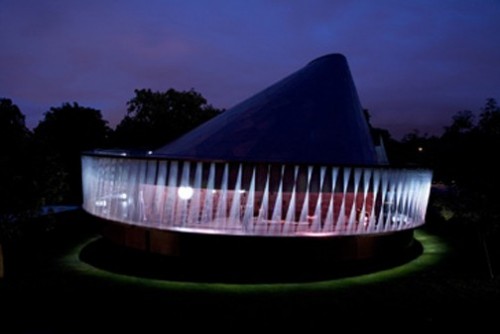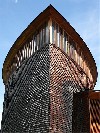Peter Zumthor to Create Pavilion
Serpentine Gallery Hosts Swiss Pritzker Prize Winner
By: Mark Favermann - Apr 09, 2011
On a bitterly cold overcast day last December, after visiting a number of quite fine exhibits at London's venerable Victoria & Albert Museum, I decide to walk the 3/4s of a mile or so to the cutting edge contemporary Serpentine Gallery in Kensington Gardens. I was going there to view an outdoor installation of sculptures by Anish Kapoor and a couple of sound/image environments by a Paris-based artist Philippe Parreno. The green softness of the park wet from London weather was a visual and tangible respite from the hard grey and brick London streets.
As I approached the small museum, I noticed a distinguished looking bearded middle aged man setting strings on the lawn adjacent to the museum. His staff and museum personnel were assisting him in creating a geometric layout. I had chanced upon a star architect literally developing a sketch in space of a structure to be built on the site during the Spring 2011.
The Serpentine Gallery Pavilion Project each year commissions an eminent architect to create a temporary pavilion. This year it had chosen the 2009 Pritzker Prize-winning Swiss architect Peter Zumthor for 2011's structure. He is collaborating on the summer pavilion with designer Piet Oudolf. This is architecture as art object. The series of stunning pavilions are temporary structures built as permanent buildings. Many have been architectural jewels that literally disappear after three or four months.
The Serpentine Gallery Pavilion series is now entering its eleventh year. It is the world's first and most ambitious temporary architectural structure commissioning program by any museum or arts institution. These temporary pavilions have been part of the Serpentine's summer offerings since 1999. Past eminent architects include Zaha Hadid, Rem Koolhaus, Daniel Libeskind, Oscar Niemeyer, Frank Gehry and Toyo Ito.
A few years later, the gallery began inviting both architects and artists to collaborate. Architect Rem Koolhaas first designed the pavilion while artist Thomas Demand created a decorative screen inside it. This was followed by Kjetil Thorsen, the Norwegian architect who co-founded Snøhetta, and Olafur Eliasson, the rising Danish installation artist. Though certainly not large, each pavilion is a real building rather than a folly.
Every Serpentine pavilion is used for talks, events, receptions and parties every week during summer months by hundreds of people at a time. They usually open in June or July and close in September, are disassembled and sold off to help pay for themselves. The resale and recycling pays for about 40% of the project costs. Previously sponsorship and National Lottery money through the British Arts Council have paid for the rest. Now that the British government is on an austerity binge, the pavilions will probably have to be paid for by only enlightened private donors and generous corporations.
This year's architect Peter Zumthor was born in Basel, Switzerland in 1943. There is a subtlety to all of his work. The son of a cabinet-maker, he first apprenticed to a carpenter in 1958 and eventually studied at the Kunstgewerbeschule in Basel in 1963. In 1966, Zumthor studied industrial design at Pratt Institute in New York as an exchange student. In 1968, he became conservationist architect for the Department for the Preservation of Monuments of the Swiss canto of Graubunden.
His work on historic restoration projects gave him a deeper understanding of construction and the particular qualities of different rustic building materials. Sensitive to construction methods, his buildings explore the tactile and sensory qualities of spaces and materials while retaining a minimalist aesthetic. He founded his own firm in 1979. His practice grew quickly and he accepted more international projects. The firm includes about 25 employees and is located in Haldenstein, Switzerland.
Peter Zumthor has a strong and resonating architectural and design philosophy. He always emphasises the sensory aspects of the architectural experience. To him, the physicality of materials can involve an individual with the world, evoking experiences and texturing perspectives of place through memory. To him, there is an undeniable "presence" in materials. All of his projects, even his most minimally conceived, reflect this.
Among his best known projects are rthe contemporarily rustic Saint Benedict Chapel in Sumvitg, Graubünden, Switzerland (1989), the Kunsthaus Bregenz (1997), cube of shimmering glass and concrete that overlooks Austria's Lake Constance, the cave-like thermal baths at Therma Vals in Vals,Switzerland (1999), the Swiss Pavilion for Expo 2000 in Hannover that was an all-timber structure intended to be recycled after the event, the Kolumba (2007), an art museum in Cologne, and the extremely minimalist Bruder Klaus Field Chapel on a farm near Wachendorf (2007).
In his design for Therme Vals, Peter Zumthor epitomizes the European practice of exploring the concurrence of contemporary architectural notions, nature, and centuries-old traditional designs. The baths were designed to look as if they pre-dated the hotel complex. They appear to be in the form of a cave or quarry-like structure. This is evident from the grass roof structure of the baths that resemble foundations of an archaeological site. This in turn reveals the form of the various bath rooms which lie below half buried into a hillside. The structure was built from locally quarried Valser quartzite slabs.
As in any high design practice, every project is not necessarily a winner or even completed in Zumthor's career. A case in point is in 1993 Zumthor won the competition for a museum and documentation center on the horrors of Nazism to be built on the site of Gestapo headquarters in Berlin. His firm's submission called for an extended three-story building with a framework consisting of concrete rods. The project was called the Topography of Terror. It was only partially built and then abandoned. The governmental agency in charge decided not to go ahead due to financial issues. The unfinished building was demolished in 2004.
Another broken project was for the Dia Art Foundation in Beacon, New York. Here, Peter Zumthor designed a gallery that was to house Walter de Maria's “360° I Ching” sculpture. The project was never completed. Recently, he turned down an opportunity to consider a new library for Oxford University's Magdalen College. Oh, well. Sometimes the most graceful of things end up lacking grace.
This year’s Serpentine Gallery Pavilion will be the architect’s first completed building in the United Kingdom and will include a specially created garden by the influential Dutch designer Piet Oudolf. At the heart of Pavilion is a garden that the architect hopes will inspire visitors to become observers. The design emphasizes the role the senses and emotions play in our experience of architecture. With a highly refined selection of materials, Zumthor creates contemplative spaces that evoke the spiritual dimension of our physical environment. As always, Zumthor’s aesthetic goal is to customize each building precisely to its purpose as a physical body and as an object of emotional as well as aesthetic experience.
According to Zumthor, "the concept for this year’s Pavilion is the hortus conclusus, a contemplative room, a garden within a garden. The building acts as a stage, a backdrop for the interior garden of flowers and light. Through blackness and shadow one enters the building from the lawn and begins the transition into the central garden, a place abstracted from the world of noise and traffic and the smells of London – an interior space within which to sit, to walk, to observe the flowers. This experience will be intense and memorable, as will the materials themselves – full of memory and time."
The Zumthor Pavilion will be constructed of a lightweight timber frame wrapped with scrim and coated with a black paste mixed with sand. Exterior and interior walls with staggered doorways will offer multiple paths for visitors to follow, gently guiding them to a central, hidden inner garden. With this Pavilion, as with previous structures , Zumthor has emphasised the sensory and spiritual aspects of the architectural experience that involves the precise but simple composition and materials used as well as the handling of sense of scale and the effect of light. The pavilion will be open from July through September 2011.
The Serpentine’s Pavilion commissions were conceived in 2000 by Gallery Director Julia Peyton-Jones. With this series, the Serpentine has become an international site for advanced architectural experimentation by some of the world’s greatest architects. Each pavilion is sited on the Gallery’s lawn for three months. Working with the immediacy of the commission, there is roughly six months from invitation to completion. Here at the Serpentine beauty is temporal as well as structural.



